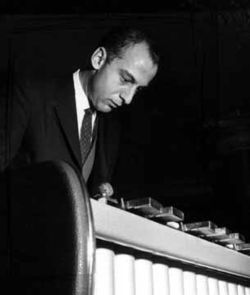Feldman, Victor
Biography
Born: April 07, 1934
Died: 1989
Country: London, England
Studies:
Teachers:
Feldman caused a sensation as a musical prodigy when he was "discovered", aged seven. His family were all musical and his father founded the Feldman Swing Club in London in 1942 to showcase his talented sons. Feldman's first professional appearance was playing drums at No. 1 Rhythm Club as a member of the Feldman Trio with brothers Robert on clarinet and Monty on piano accordion. He featured in the films King Arthur Was a Gentleman (1942) and Theatre Royal (1943). In 1944 he was featured at a concert with Glenn Miller's AAAF band, as "Kid Krupa" (in reference to drummer Gene Krupa). His drums teacher Carlo Krahmer encouraged Feldman to play the vibraphone which he did first in the Ralph Sharon Sextet and later in the Roy Fox band. He worked in India in 1952 and 1953 in a band led by pianist Eddie Carroll. His vibraphone and conga drum playing were notable, but it was as a pianist that he became best known.
Before leaving the U.K. in 1955 to work in the U.S., Feldman recorded with Ronnie Scott's orchestra and quintet from 1954 to 1955, which also featured other important British jazz musicians such as Phil Seamen and Hank Shaw. It was Scott who recommended that Feldman emigrate to the U.S., which he did in 1957. Once there, his first steady work was with the Woody Herman Herd. From there he went on to join Buddy DeFranco. In 1958, he had his own working band on the west coast, which included the innovative bassist Scott LaFaro. His 1958 Album The Arrival of Victor Feldman includes LaFaro and Stan Levey on drums. He recorded with many different jazz artists, including Benny Goodman, George Shearing, Cannonball Adderley and Miles Davis, most notably on Davis' 1963 album Seven Steps to Heaven, the title tune being his own composition. The 5-CD Shelly Manne Black Hawk set, originally released on LP in September, 1959, is a good representation of Feldman's unmistakable driving "comping" behind the soloists, helping to define the session as a valuable hard bop genre element.
In 1957 Feldman settled in Los Angeles permanently and then specialized in lucrative session work for the US film and recording industry. He also branched out to work with a variety of musicians outside of jazz, working with artists such as Frank Zappa in 1967, Steely Dan and Joni Mitchell in the 1970s and Tom Waits and Joe Walsh in the 1980s. Feldman died at his home, aged 53, following a heart attack. In 2009, Feldman was inducted in the Musicians Hall of Fame and Museum in Nashville, TN. [1]
Works for Percussion
All Alone by the Vibraphone - Vibraphone
Just a Simple Samba - Vibraphone; Chamber Ensemble (Jazz)
Let Me Count the Ways - Vibraphone; Chamber Ensemble (Jazz)
Mallets in Wonderland - Mallets
References
